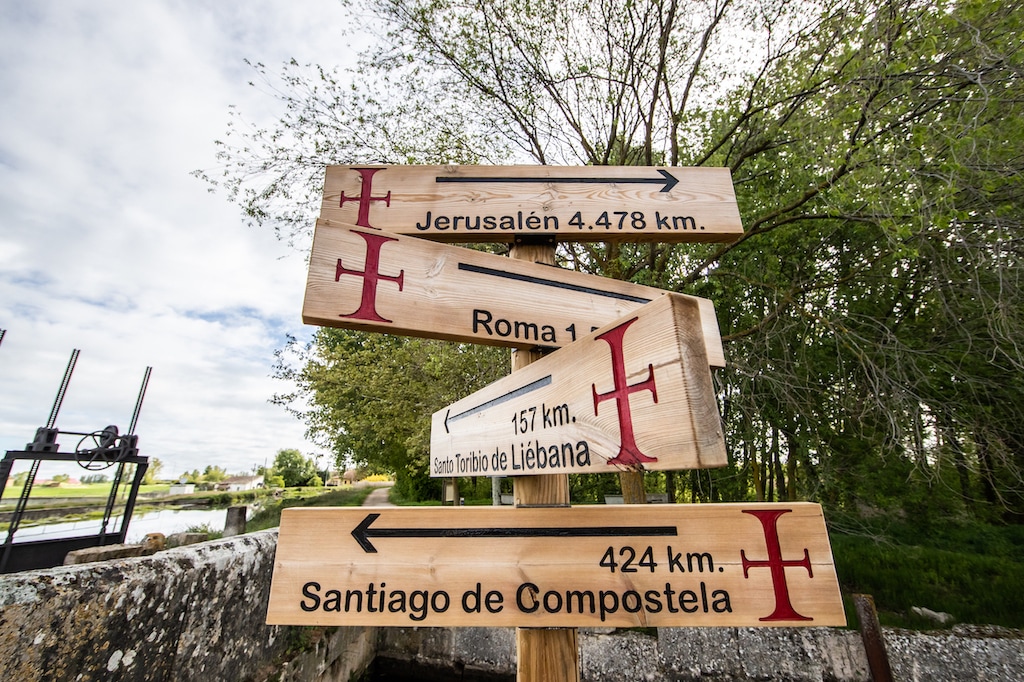We at Out Adventures are ecstatic to host our first gay Camino de Santiago hike. To help potential guests such as yourself feel prepared for the journey, we’ve compiled everything you need to know before booking this unforgettable pilgrimage.
Introduction to our gay Camino de Santiago hike
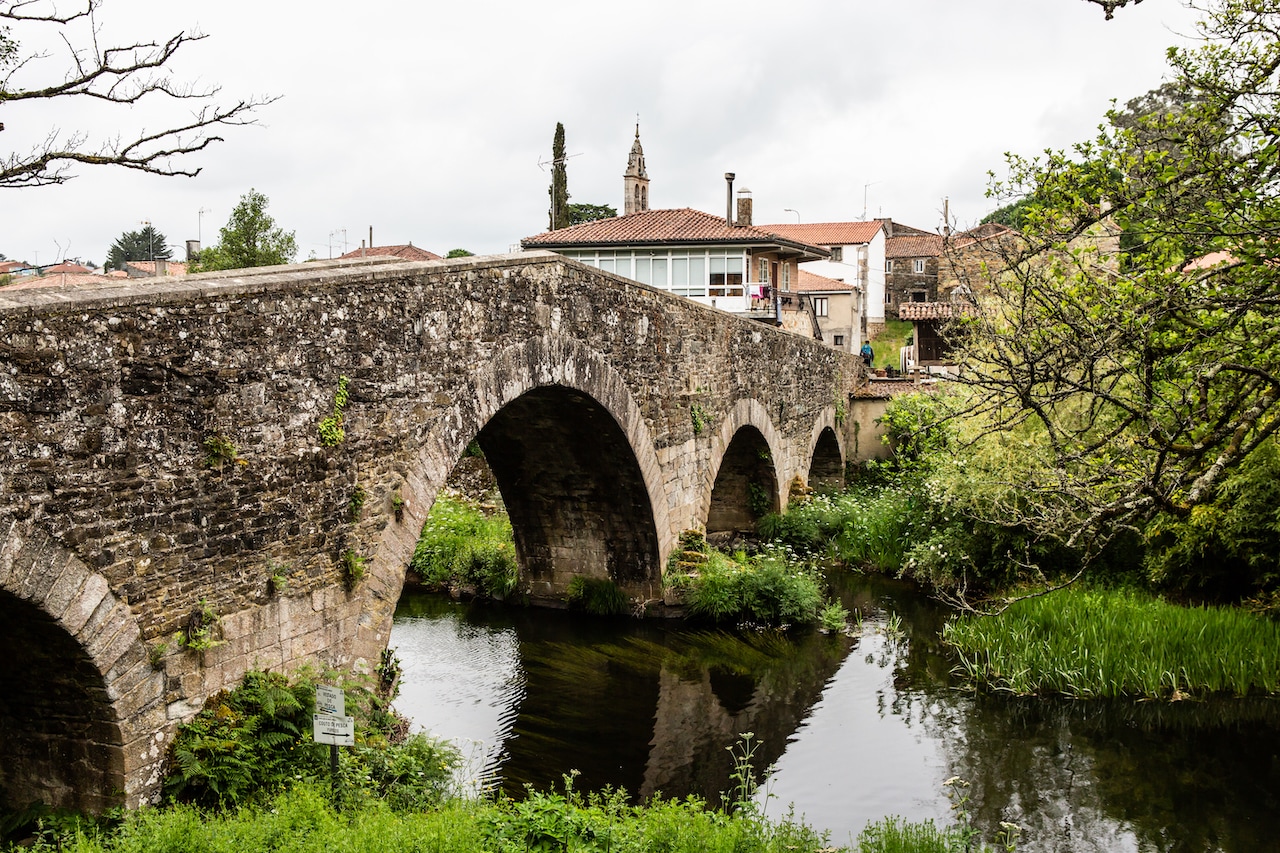
What is the Camino de Santiago?
The Camino de Santiago, or The Way of Saint James, is one of the oldest and most famous pilgrimage routes in Europe. Pilgrims came on foot from all over Europe to the Cathedral in Santiago de Compostela in order to receive their plenary indulgence. In 2019, the Pilgrims’ Office reported 40% of all pilgrims walked for religious reasons.
Today, pilgrims walk ‘The Way’ for many different reasons. Some walk to escape from their busy lives and have time to contemplate. Others walk to explore a new country or to be part of a unique gathering of people from all around the world. Some of the pilgrims see it as an opportunity to take on a physical challenge. Whatever your motivation to set out on foot is, the experience offers all of the above and more.
What will I see/experience on Out Adventures gay Camino de Santiago hike?
The Last 100 kilometers is walked exclusively in Galicia, Spain’s green oasis in the North. You will be walking through beautiful oak woodlands, fragrant eucalyptus forests and traditional Galician villages.
This area is famous for the wines produced there (both red and white), its seafood (pretty much everything the Atlantic has to offer), and its cheese (curiously shaped in the form of a breast). You can count on enjoying all of these things.
On this special Camino tour, you explore Madrid, the vibrant capital of Spain through its dynamic culture, food and traditions. We explore Finisterre, which was until the Middle Ages considered to be the “End of the World”; and visit Muxía, an important pilgrimage site with stunning views of the impressive and dramatic coastline.
On this tour, we finish our Camino with a stay in the famous Parador Hostal dos Reis Catolicos in Santiago de Compostela, the luxury Spanish hotel renovated from a pilgrim’s hospital from the year 1486.
What/where is Galicia?
Galicia is an autonomous region in Spain, located as far northwest as you can get in the country. It sits over Portugal and is home to one of the four official languages in Spain: Galician.
Galicia is considered the seventh Celtic nation and has a culture rich in tradition. The Galician gaita, or bagpipe, music is still popular today. There also remains the practice of traditional Pagan rituals (as the Queimada).
The capital of Galicia is Santiago de Compostela, which is home to the finishing point of the Camino de Santiago – The Cathedral of Santiago de Compostela.
Difficulty of our gay Camino de Santiago hike
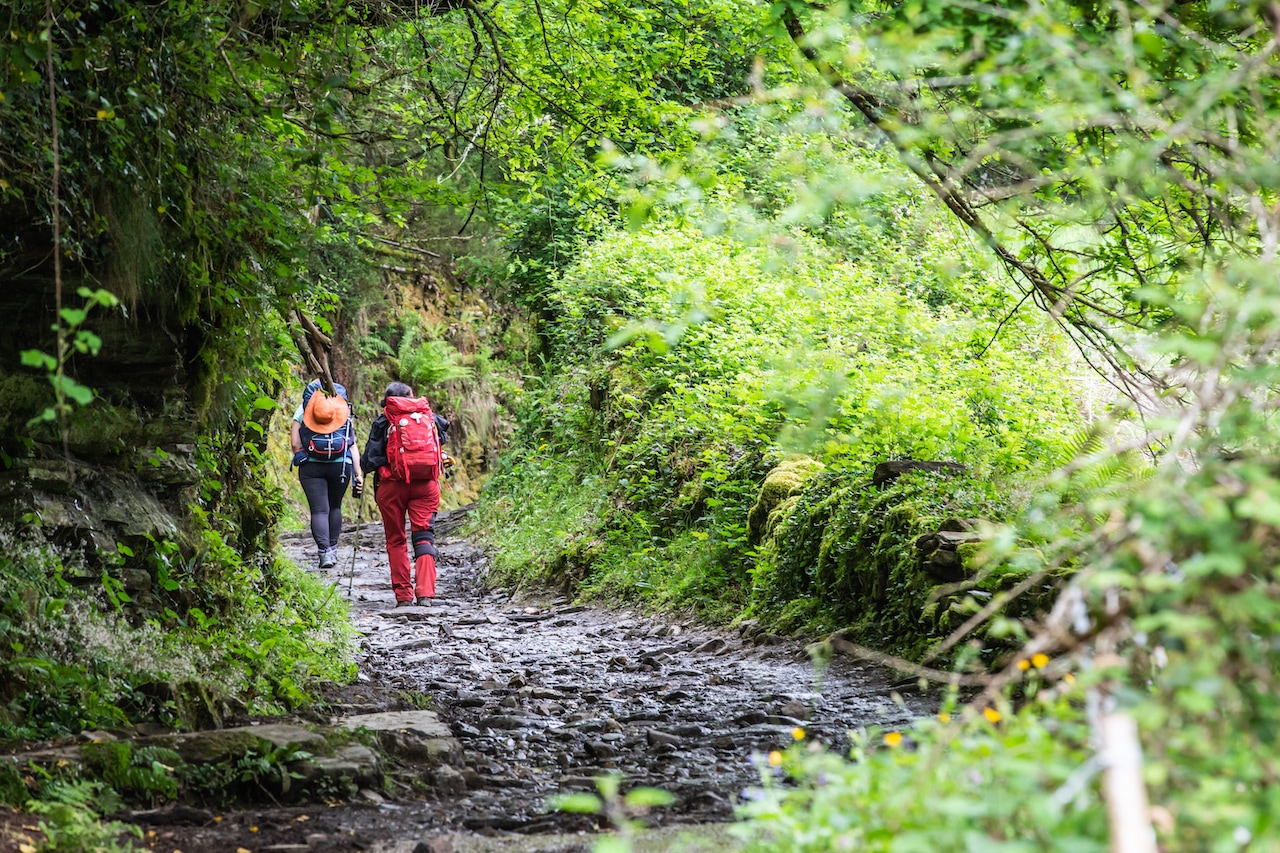
How difficult is the Camino de Santiago?
You don´t need to be super-fit to walk the Camino. However, being in good walking shape does help you enjoy the experience. The longest distance we normally cover is around 16 miles/26km in one day, but we have all day to walk. There are lots of places to stop and rest along the way and we also have a support vehicle if your legs need a break!
It’s a good idea to get your legs and feet used to walking several miles at a time. Try to walk 5-10 miles a couple of times before your trip – including some uphill and downhill whilst carrying your backpack. The distances we plan for you are the typical ‘etapas’, or stages, of the Camino.
What route will Out Adventures take on the Camino de Santiago?
Our private Camino tour is going to traverse one the most famous and popular sections of the Camino – the Camino Francés. In 2019, 55% of the pilgrims who walked the Camino de Santiago did so on the Camino Francés. This was followed by 21% on the Camino Portuguese. Walking the Last 100 kilometres of the Camino means that you can request your ‘Compostela’, or certificate of completion of the pilgrimage.
How far do we hike each day and what is the terrain like?
This part of the Camino is very well marked and follows mainly forest trails, paths between villages and some secondary roads. While it is certainly not a mountainous region, Galicia is never flat!
You will find that virtually every guide book, map, and website you read has a different number of kilometres/miles for each stage of the Camino. You will also find that virtually none of those match up to the stone markers you will see on the trail, or to your pedometer if you use one! We have given our own estimate on mileage and from experience find it is best not to take much notice of exact distances. Obviously, a 20k day feels very different to a 30k day, but so many other factors influence the “level of difficulty” – trail surface, weather and how you are feeling are as much to do with your experience as the distance and number of metres/feet climbed up and down. Just put one foot in the front of the other and enjoy the view!
What support will I have on the trail from Out Adventures?
All of our fully-guided Camino trips have at least 1, though normally 2 English/Spanish speaking guide/s. Generally, on these trips we aim to have one guide walk along the trail when possible. Although this does not mean the guide will be walking next to you. Our other guide drives our support vehicle doing checkpoints along the trail.
Our guides know the Camino like the back of their hands. Each day they will give you a daily map and overview of the walk ahead. This map will include information such as the daily terrain, checkpoint locations, lunch spots, highlights to see along the way, and other important items such as the best place to get a fun stamp! If you need support with anything, from asking for something in Spanish to getting to a doctor, we will be there to help.
Our September 2020 tour will also be hosted by Scott Marquardt.
If I have a recent injury, surgery, special physical requirement, can I still participate? What safety precautions are in place?
Absolutely! We will ensure to gather info about your health needs in advance so we can take any necessary precautions. We are also happy to talk to you one on one if you need reassurance about any identified need. We are here to ensure your individual Camino goal is obtained and you can reach Santiago safely.
If you need to shorten your walking day, our guides can tell you the best part of the trail to walk that day – whether you need to avoid the steep incline/decline, or if you need to stick to softer walking paths. Our guides can also make sure they provide extra checkpoints for you throughout the day.
Also, we kindly asks anyone over the age of 70 to get a note from their doctor simply saying they’re in good enough condition to participate. We thank you in advance.
I’m worried I might be the slowest/fastest walker. Can the team split up so I don’t hold other walkers up?
This is our MOST important Camino de Santiago information and advice: we encourage everyone to walk at their own pace. The Camino is not a race and you want to enjoy yourself. When you slow down or speed up to walk with others, you find you may have issues with your body and/or feet. We plan our days so that everyone can walk in their own way.
Packing for our gay Camino de Santiago hike
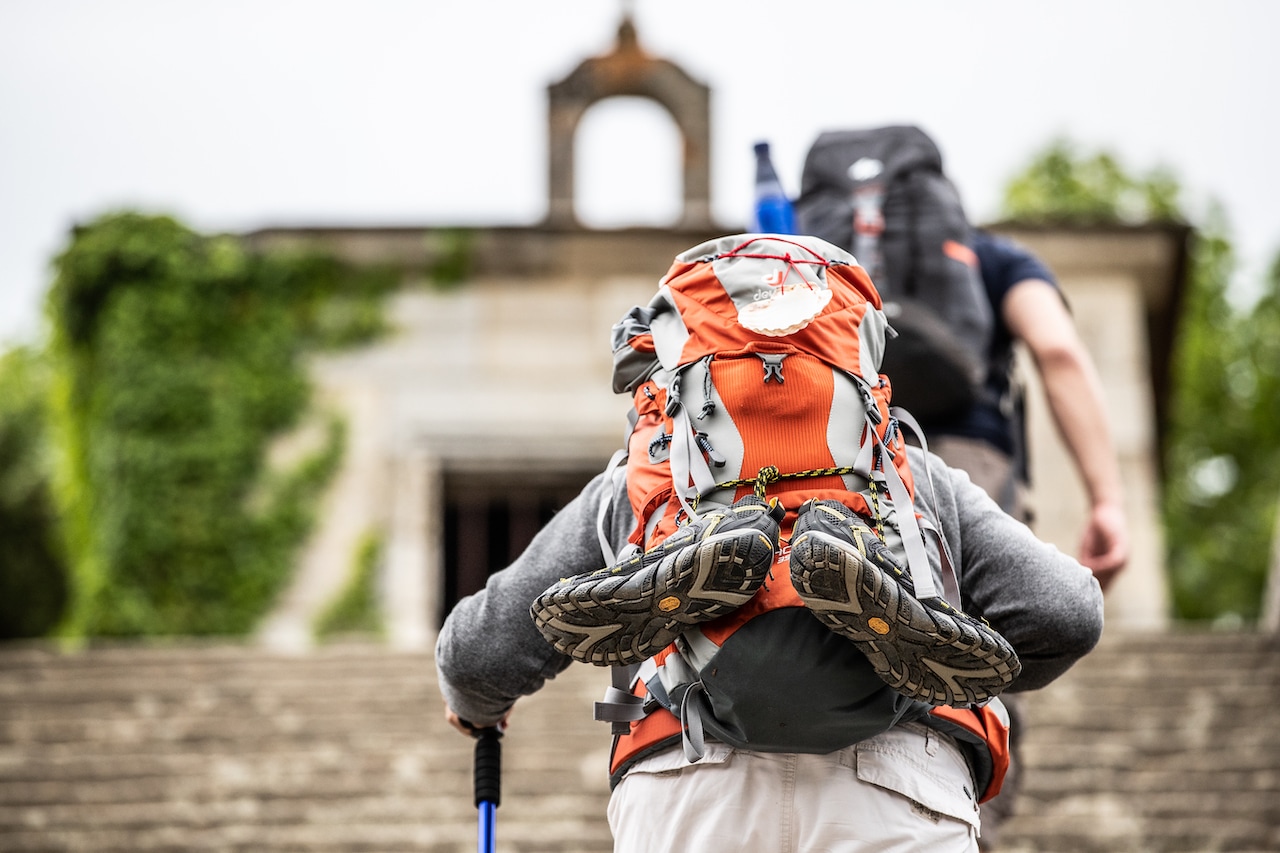
When is the best time to do the hike? When is Out Adventures’ hike?
Having done the trails in all months of the year, we think each month brings its own unique experience and beauty. Our tour is in September, one of our most favorite times to walk The Way! During this time, you experience milder temperatures and the trail is busy but not overly crowded.
What will the weather be like and how should I prepare accordingly?
That´s the million-dollar question! The north of Spain does not experience the scorching temperatures typical of the south and centre, and Galicia has an oceanic climate, with mild temperatures and regular rainfall.
September generally has very pleasant temperatures. The average minimum temperature is 13°C or 55°F; the average maximum temperature is 22°C or 72°F. We always suggest bringing a rain jacket or poncho for rain, as well as a light sweatshirt for the cool mornings and evenings. It can actually be nice to experience the Camino in rain and shine!
Will I have to carry all of my own luggage?
From the starting point in Madrid, to the ending point in Santiago de Compostela, we take care of all luggage handling and transportation. For the luggage, this means leaving your bags at a designated area in the hotel and starting your walk. Your guides handle the details of getting them into the next hotel room. We also find it handy to keep a small bag in the van with stuff you might need throughout the day.
Anything specific I should pack?
Our advice is to not bring too much! Find our recommended Camino de Santiago packing list here.
What kind of hiking shoes/boots are appropriate for the Camino?
This is really a personal decision. You will be spending a lot of time on your feet, so the most important thing to consider is comfort. You don´t need rigid mountaineering boots, but if you like to have some ankle support, lightweight waterproof boots are a good option. Otherwise, a good quality waterproof walking shoe with a good grip is fine. Make sure you do plenty of walking in the boots/shoes you plan to bring in order to check they are suitable! Bring some spare footwear for exploring towns in the evenings.
Accommodations used on our gay Camino de Santiago hike
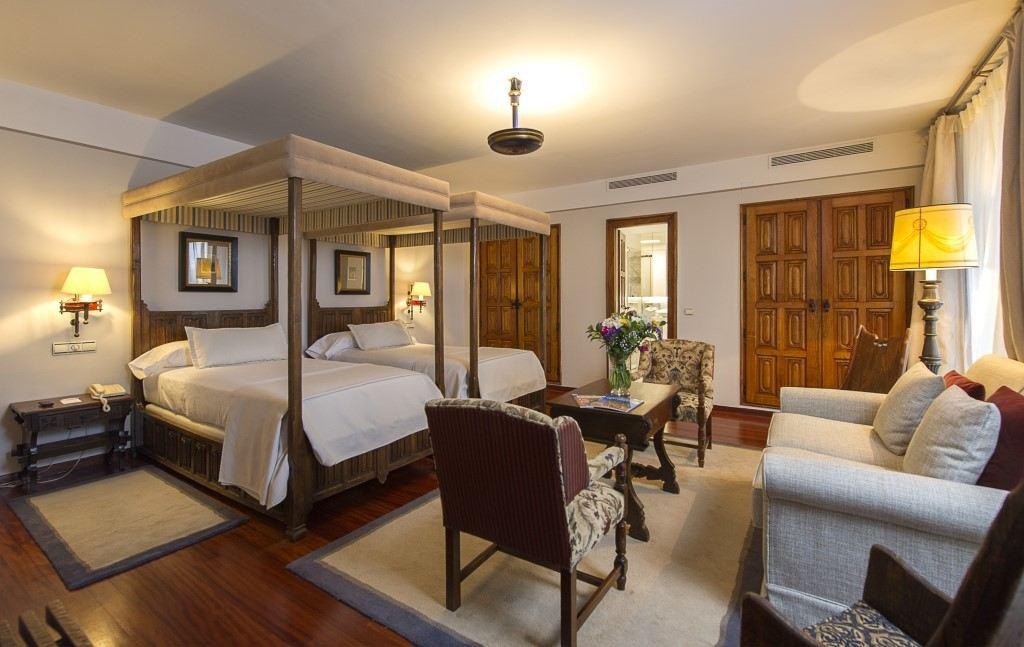
Where will I sleep? What are the accommodations like?
All of our accommodations are carefully chosen for their proximity to the Camino, charm and quality of service provided. We stay in small rural farmhouses or manor houses wherever possible. These are similar to bed and breakfasts and are usually traditional houses typical of the region, full of character and run by local people. On some nights, we use hotels so you will experience a mix, always of good quality!
Should I bring anything extra for the accommodations such as pillows, sleeping bags etc.
We assure you, all of our accommodations are up to snuff! Due to the myriad of hotel classifications in Spain, it’s not as trustworthy to count on the stars as it may be in other parts of the world. All accommodation will provide linens, towels, toiletries, etc. No need to bring anything unless you have a preference for a specific item.
Can I purchase a single supplement if I don’t have a travel buddy? How much is it?
A single supplement is available. For departure dates and pricing, visit our Spain Gay Madrid & the Camino de Santiago page.
Money on the Camino de Santiago
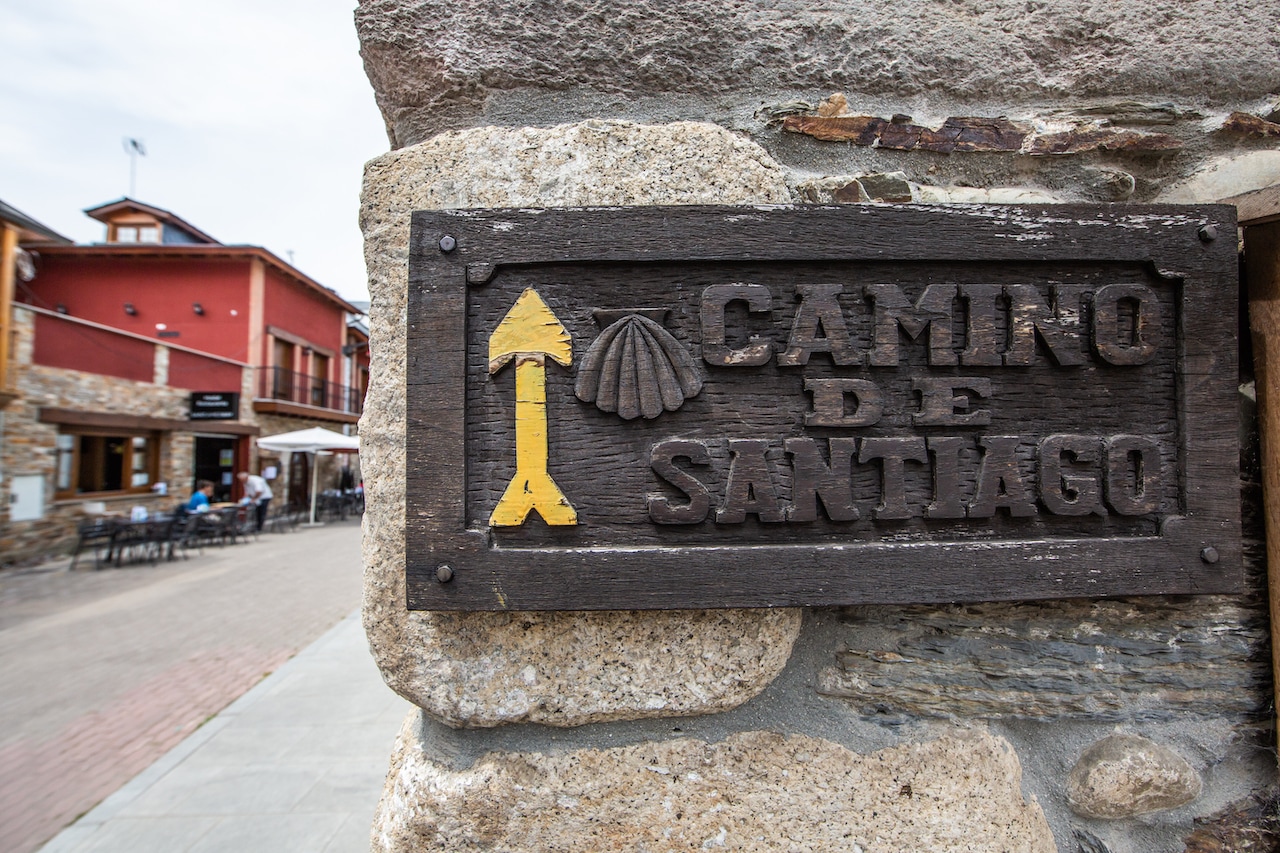
What is the currency in Spain?
Spain’s currency is the Euro. We suggest exchanging money in advance to bring with you or you can find money exchanges in the airport when you arrive. It´s a good idea to have some Euros with you – best to have notes of 50€ or 20€. There are notes of 500€, 200€, 100€, 50€, 20€, 10€ and 5€. 500€, 200€ and 100€ are not the best for small purchases as some establishments will not take these notes.
Will my credit/debit card work in most places along the trail?
Some bars and restaurants on the Camino don´t accept credit cards. We recommend having a small amount of cash on you during the day for any extra coffees/drinks along the trail. You can use credit cards in most large stores and shops. Make sure you check with your bank that your card is ready to use abroad.
Are there many ATMs in the region?
In most small towns and in all cities, you will find banks with ATM machines. We will let you know about where the next available ATM will be if necessary. Again, make sure your card is authorized to use whilst abroad.
Dietary needs on our gay Camino de Santiago hike
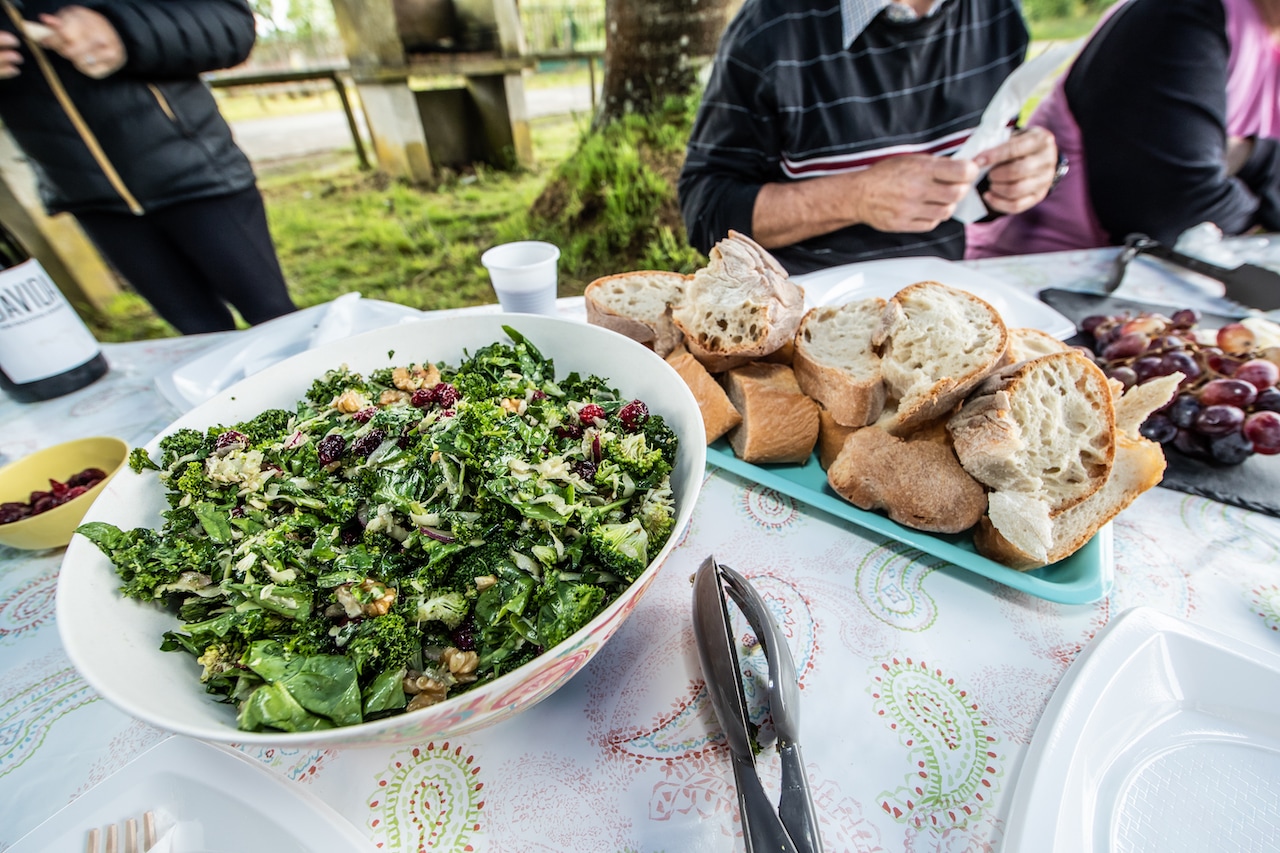
What will I eat?
On our gay Camino tour we include all breakfasts, 6 lunches and 8 dinners including wine. You will have the chance to try great typical Galician food such as ‘pulpo‘ (octopus with paprika), ‘empanada‘ (hearty savoury pastry), Spanish ‘tortilla‘ (a potato and egg omelette), ‘Tetilla’ (cow’s milk cheese in the shape of a woman´s breast), ‘albariño’ (Galician white wine), ‘Tarta de Santiago‘ (traditional almond cake), and ‘Caldo Gallego’ (ham broth with chard and potatoes).
We provide gourmet picnic lunches prepared by our Camino guides. Our picnics include fresh salads and lighter options, all taking into consideration any food allergies or lifestyle choices as vegetarian, vegan, lactose-free, etc. We use local products so you are always tasting the typical foods of the area. We also ensure you are discovering any fresh vegetable and/or fruit that are in season at the time of your Camino walk.
Normally on the trail, we have dinner in our accommodation. You get a wide variety of dinners on our guided Camino trips from a family-style dinner from a local organic garden with their homemade wine and liquors; to a home-made dinner prepared by the owners of our ‘Casa Rural‘ of authentic paella, either seafood or vegetarian. One night you may even dine in our ‘Pazo‘s’ high-end restaurant. On nights we do not eat at our hotel, we take you to our favorite local restaurants. One of our favorite restaurants is owned by pilgrim Pepe who previously was a butcher but opened a restaurant on the Camino to provide organic local cuts prepared on order. (He also serves a wide range of items including fresh fish and vegetarian/vegan options.)
Being big foodies ourselves, we ensure your bellies are full for your walking days!
How often will I eat?
All of our hotels serve breakfast before we set off for the trail. A normal breakfast in Spain consists of coffee, tea or hot chocolate, orange juice and toast or croissants. In all of our accommodation, breakfast is more substantial and provides eggs, cheese and yogurt. If breakfast is on the lighter side, we make sure we augment it to prepare you for your day of walking!
Lunch in Spain is normally eaten between 2.00 pm and 4.00 pm. This is the largest meal of the day and can be quite heavy. This is why we provide picnic lunches with lighter options. Your time for lunch is largely dependent on your walking pace. Our guides will ensure lunch is fresh and ready for our fastest walkers and for our pilgrims who like to take a little more time.
Dinner is usually later in Spain. This gives you time to have a shower, relax and recuperate, explore the area and maybe have a glass of wine!
Are snacks provided or should I bring my own?
We provide water and snacks at our “checkpoints.” Our snacks consist of fresh local fruit, a variety of granola bars, mixed nuts, delicious pastries, and anything else specific to our group’s needs. Walking with us also means you do not need to carry lots of water or fill up from the public fountains. (We do not know how often the fountains are treated, thus we do not advise to drink from them.) We provide water at our checkpoints to fill up your water bottle.
What if I have a dietary preference or allergy? Is Spain/Galicia/Out Adventures accommodating to food allergies?
Before you set off for Spain, we gather any specific food intolerance/allergies and we will plan ahead to make sure we can meet your needs. This is never a problem in restaurants or for our picnic lunches. Do make sure you bring any allergy medication you might need.
Vegetarian or vegan food is not the norm and options can be limited. Restaurants along the Camino are getting much better at understanding and providing vegetarian options. We will ensure your dietary needs are met.
LGBT Acceptance in Spain and on the Camino
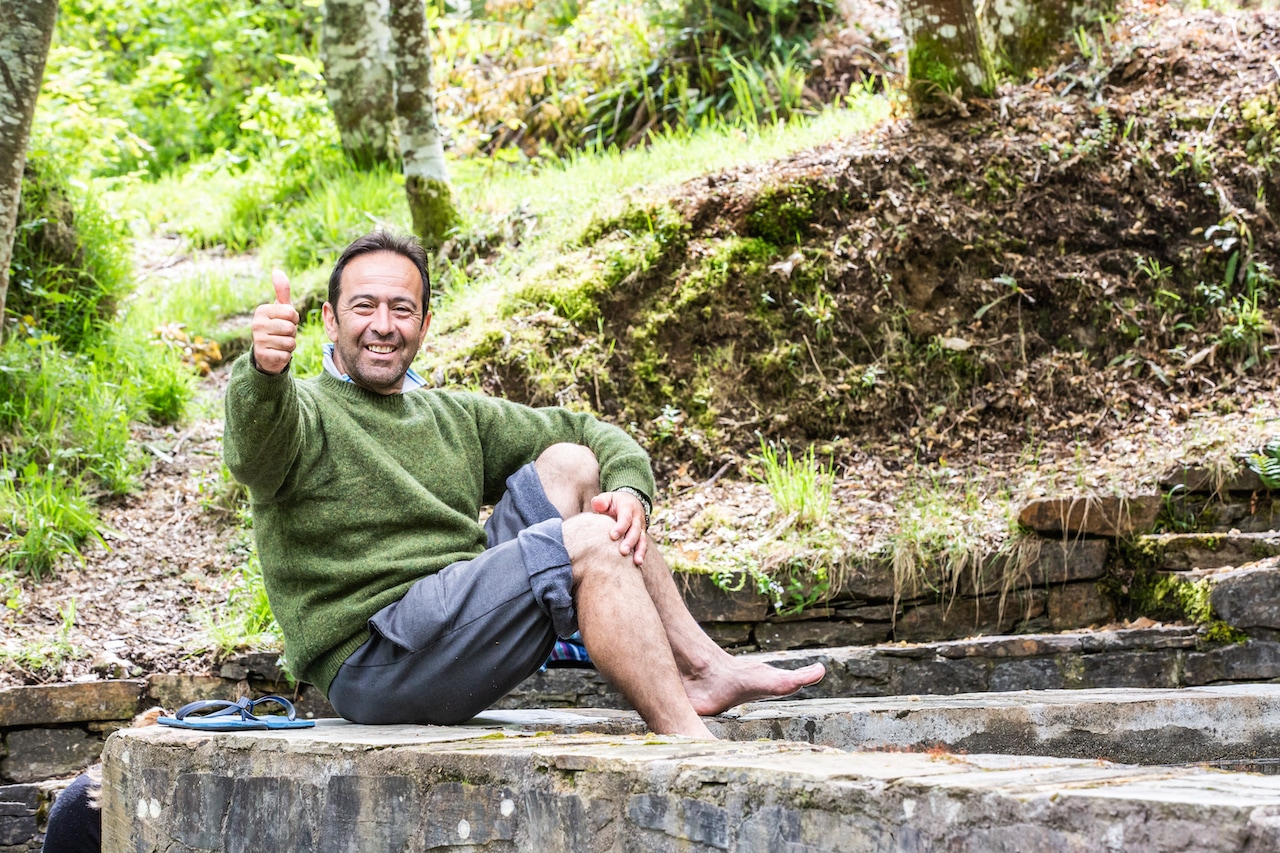
Is rural Spain and Galicia gay-welcoming?
Spain has been recognized for providing one of the highest degrees of liberty in the world to its LGBT citizens. In 2005 Spain became the 3rd country in the world to legalize same-sex marriage. The new law gave all of the same marital and adoption rights as heterosexual couples. Discrimination in employment regarding sexual orientation has been banned nationwide since 1995 and LGBT people have been allowed to openly serve in the military since 2005.
Spain is one of the most culturally liberal and LGBT-friendly countries in the world. The cities of Madrid and Barcelona also have a reputation as two of the most LGBT-friendly cities in the world. Madrid pride is one of the largest celebrations in Europe and draws many guests each year to visit the country. Vanessa, one of the owners of our local partners, has been married and living with her wife in rural Galicia since 2015. Ashleigh, her wife, states that despite living in London for 10 years, rural Galicia has been the most accepting of her marriage to Vanessa.
Will we get a taste of Madrid’s famous gay scene?
On this special gay Camindo de Santiago tour, you’ll enjoy a private walking tour of Madrid city centre by a local expert gay guide. The tour starts in ‘Puerta del Sol‘, the heart of the capital. We will walk the main street where you will discover some of the oldest buildings in Madrid, as well some of the most beautiful plazas. We finish the tour with lunch at a local market to taste the local food and wine. During the tour, you will learn about the city’s gay history, lifestyle and nightlife.
After finishing your Camino de Santiago, we return to Madrid and celebrate in it’s gay neighborhood, ‘Chueca‘, by experiencing the night life in some of it’s most popular gay bars, with a private tour guide leading the way!
Buen Camino!
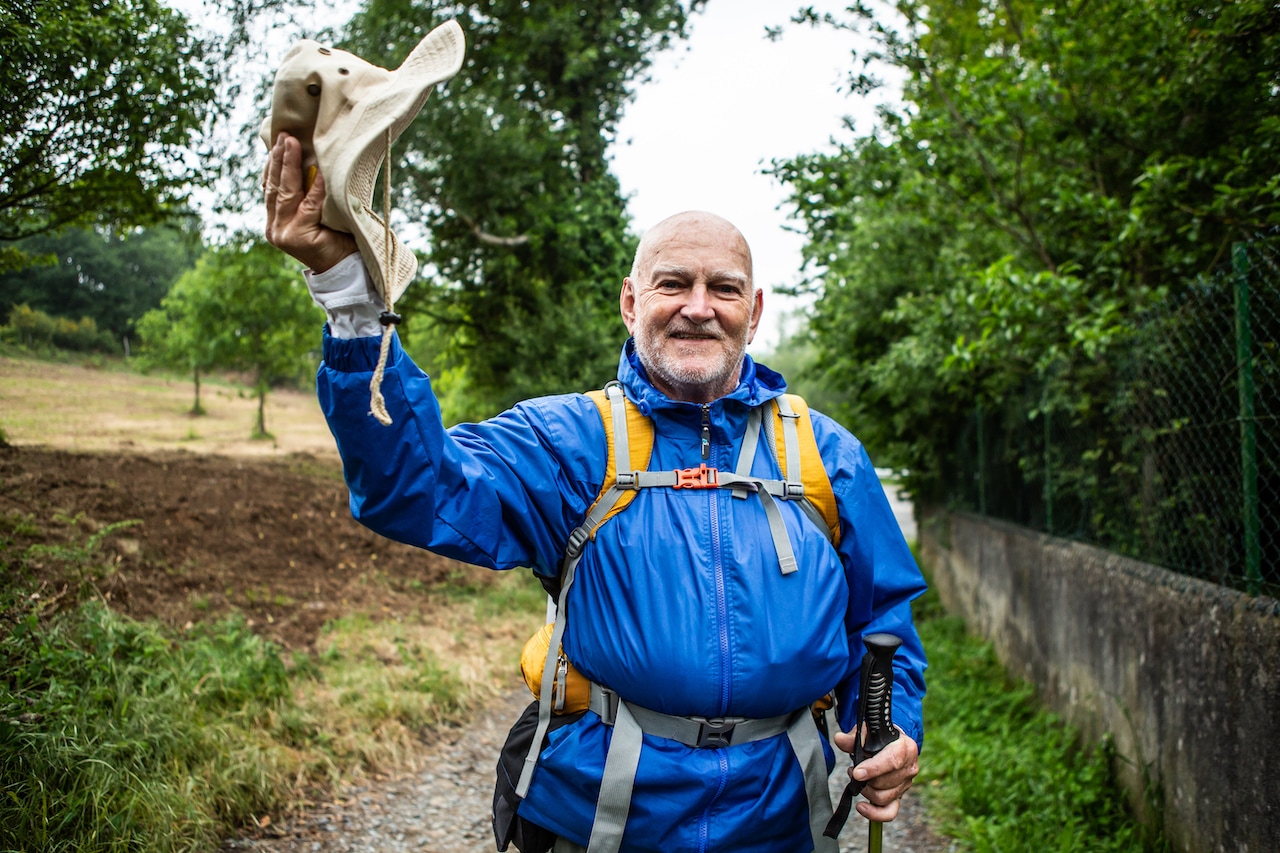
This is a phrase you will hear, and hopefully say too, as you walk this beautiful and historic road to Santiago de Compostela. It literally means “Good Way” in Spanish. Local people and other pilgrims will wish you a good journey as you pass through the many hamlets and small market towns that have lined the Camino de Santiago for centuries. If someone says it to you, the reply is ‘Gracias, igualmente’ (Thank you and to you); or you can just say it back, ‘BUEN CAMINO!’

Ashleigh Mell is the marketing manager at Andaspain and a Camino guide. She was born and raised in the USA but has since fallen in love with Santiago de Compostela and has made it her home.
Featured Posts
We're off to Spain to hike the Camino de Santiago. But before we hit the trails, we'll spend some time in Madrid. Here's our big gay Madrid guide.Read More
Sweat and schlep on one of Out Adventures' epic international Gay Hikes. From the Peruvian Andes to exhausting Everest Base Camp.Read More
For the first time ever, Out Adventures touches down in Madrid, then Spain’s northern province of Galicia for an active gay adventure along the Camino de Santiago, or Way of Saint James. Today this landmark Catholic pilgrimage is just as popular with secular wayfarers including LGBT trekkers, and Spain is already one of the most gay-welcoming […]Read More
Six tips to best prepare for Out Adventures gay trek to Everest Base Camp, Nepal.Read More
10 nuggets of wisdom to consider before booking Out Adventures' gay hike towards Machu Picchu, Peru.Read More
The Azores Islands are a gorgeous archipelago in the middle of The Atlantic. Here's a handful of photos from our 2019 gay Azores tour.Read More
Based on the feedback of past gay Everest explorers, here are the top ten things they wish they had known before hitting the Himalayas. Read More
